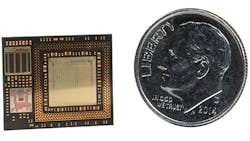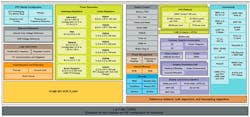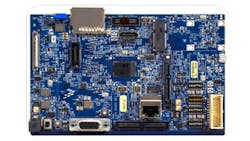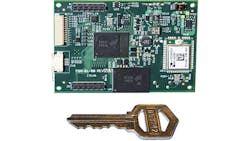Freescale’s i.MX 6Dual SCM (single chip module) mixes an SoC with DRAM and SPI flash via a multichip carrier for a highly integrated Internet of Things (IoT) platform (Fig. 1). It packs in 16 Mbytes of SPI NOR flash memory and 1 or 2 Gbytes of LPDDR2 memory with a dual-core, ARM Cortex-A9 system on-chip (SoC).
This is one chip that I think will have a significant impact on IoT applications because of the integration that used to be exclusive to mobile platforms where the cost could be borne by top-end smartphones. The i.MX 6Dual SCM is relatively inexpensive and low power, while providing a great development platform.
The SoC reduces a three-chip system to a single chip that is more efficient and more powerful than earlier i.MX platforms. The dual ARM cores are blended with impressive graphics and imaging capabilities (Fig. 2). The graphics engines support 2D and 3D multimedia. It has 1080p30 encode and decode support for streaming media. The image processing unit (IPU) supports image enhancement. The display and camera input support includes HDMI and LVDS display support as well as 20-bit CSI (camera serial interface) and MIPI interfaces.
Security is critical to IoT and the chip has a hardware random number generator as well as secure boot support. It supports ARM’s TrustZone and it even has a secure real time clock (RTC).
The chip is designed for connected applications. Off-chip wireless will be common, but its on-chip wired connectivity including USB 2 with PHYs including OTG support, dual FlexCAN interfaces, lots of serial interfaces including SPI and I2C, and 1 Gbit Ethernet with IEEE 1588 support. Other interfaces include x1 PCI Express 2.0, MIPI HSI, S/PDIF audio, and I2S/SSI. For storage the chip supports MMC 4.4, NAND flash memory controller, and 3 Gbit/s SATA with PHY. These interfaces provide expansion if developers need more than the support built into the chip.
The chip has a very compact form factor at only 17 mm by 14 mm. It is only 1.7 mm high. The chip is dwarfed by its development board (Fig. 3). The board provides access to all the interfaces including a mini-PCIe socket.
Software support already exists for the i.MX platform. These tools are compatible with the i.MX 6Dual SCM. There is a wide selection of operating systems available for i.MX systems including Linux, Micrium’s µC/os II and III and Green Hiils Software’s Integrity.
InHand Electronic’s Fury-M6 (Fig. 4) takes advantage of the i.MX 6Dual SCM. The Fury-M6 adds 802.11 b/g/n and Bluetooth BLE wireless support as well as an LCD with touchscreen in a 2.75-in by 2-in package. The system also has a built-in battery charger and exposes a host of peripheral interfaces. It can run Linux or Android.
Freescale has essentially packed a module into a single chip that can run without a heatsink while providing a very powerful IoT platform.
About the Author
William G. Wong
Senior Content Director - Electronic Design and Microwaves & RF
I am Editor of Electronic Design focusing on embedded, software, and systems. As Senior Content Director, I also manage Microwaves & RF and I work with a great team of editors to provide engineers, programmers, developers and technical managers with interesting and useful articles and videos on a regular basis. Check out our free newsletters to see the latest content.
You can send press releases for new products for possible coverage on the website. I am also interested in receiving contributed articles for publishing on our website. Use our template and send to me along with a signed release form.
Check out my blog, AltEmbedded on Electronic Design, as well as his latest articles on this site that are listed below.
You can visit my social media via these links:
- AltEmbedded on Electronic Design
- Bill Wong on Facebook
- @AltEmbedded on Twitter
- Bill Wong on LinkedIn
I earned a Bachelor of Electrical Engineering at the Georgia Institute of Technology and a Masters in Computer Science from Rutgers University. I still do a bit of programming using everything from C and C++ to Rust and Ada/SPARK. I do a bit of PHP programming for Drupal websites. I have posted a few Drupal modules.
I still get a hand on software and electronic hardware. Some of this can be found on our Kit Close-Up video series. You can also see me on many of our TechXchange Talk videos. I am interested in a range of projects from robotics to artificial intelligence.




